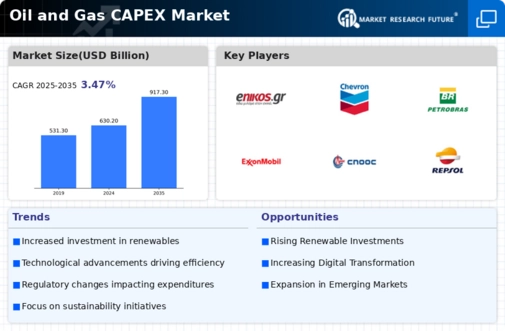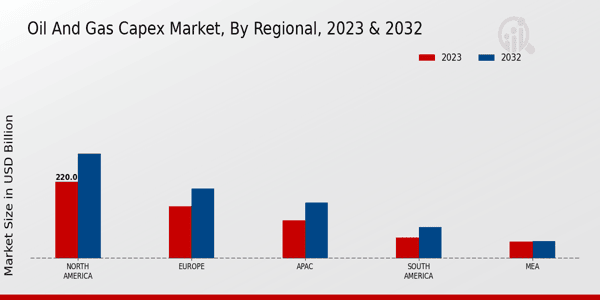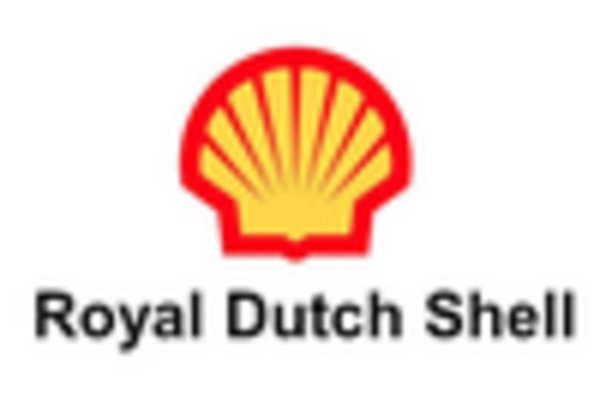Geopolitical Factors
Geopolitical factors are a significant driver of the Oil and Gas CAPEX Market. Political instability in key oil-producing regions can lead to supply disruptions, prompting companies to invest in alternative sources and infrastructure to mitigate risks. Furthermore, trade policies and international relations can influence investment decisions, as companies seek to navigate tariffs and sanctions. In 2025, it is expected that geopolitical tensions will continue to shape capital expenditure strategies, as firms prioritize investments in regions with stable political climates. This focus on geopolitical stability may lead to increased capital allocations for exploration and production in less volatile areas, thereby impacting the overall landscape of the Oil and Gas CAPEX Market.
Regulatory Environment
The regulatory environment significantly impacts the Oil and Gas CAPEX Market. Governments worldwide are increasingly implementing stringent regulations aimed at reducing carbon emissions and promoting sustainable practices. Compliance with these regulations often requires substantial capital investments in new technologies and infrastructure. For example, companies may need to invest in carbon capture and storage systems or upgrade existing facilities to meet environmental standards. In 2025, it is anticipated that regulatory compliance costs could represent a considerable portion of capital expenditures in the industry. Additionally, the evolving regulatory landscape may create both challenges and opportunities for investment, as companies that proactively adapt to these changes may gain a competitive edge in the Oil and Gas CAPEX Market.
Increased Energy Demand
The rising The Oil and Gas CAPEX Industry. As economies expand and populations grow, the need for energy sources continues to escalate. According to recent estimates, energy consumption is projected to increase by approximately 30 percent by 2040. This surge in demand compels oil and gas companies to invest heavily in exploration and production activities, thereby driving capital expenditures. The Oil and Gas CAPEX Market is likely to see substantial investments in upstream projects, including drilling and infrastructure development, to meet this growing demand. Furthermore, the transition towards cleaner energy sources may also necessitate significant CAPEX to adapt existing facilities and technologies, ensuring that they can efficiently produce energy while minimizing environmental impact.
Market Price Volatility
Market price volatility is a critical factor influencing the Oil and Gas CAPEX Market. Fluctuations in oil and gas prices can significantly affect the financial viability of projects, leading companies to adjust their capital expenditure plans accordingly. When prices are high, firms are more likely to invest in new projects, while low prices may result in budget cuts and deferred investments. In 2025, it is anticipated that ongoing price volatility will compel companies to adopt more flexible CAPEX strategies, allowing them to respond swiftly to market changes. This adaptability is essential for maintaining competitiveness in the Oil and Gas CAPEX Market, as firms must balance the need for investment with the realities of an unpredictable market.
Technological Advancements
Technological advancements play a crucial role in shaping the Oil and Gas CAPEX Market. Innovations such as enhanced oil recovery techniques, digitalization, and automation are transforming how companies operate. For instance, the adoption of advanced data analytics and artificial intelligence is enabling firms to optimize production processes and reduce operational costs. In 2025, it is estimated that investments in digital technologies could account for a significant portion of total capital expenditures in the industry. These technologies not only improve efficiency but also enhance safety and environmental compliance. As companies strive to remain competitive, the integration of cutting-edge technologies into their operations is likely to drive further capital investments, thereby influencing the overall dynamics of the Oil and Gas CAPEX Market.


















Leave a Comment